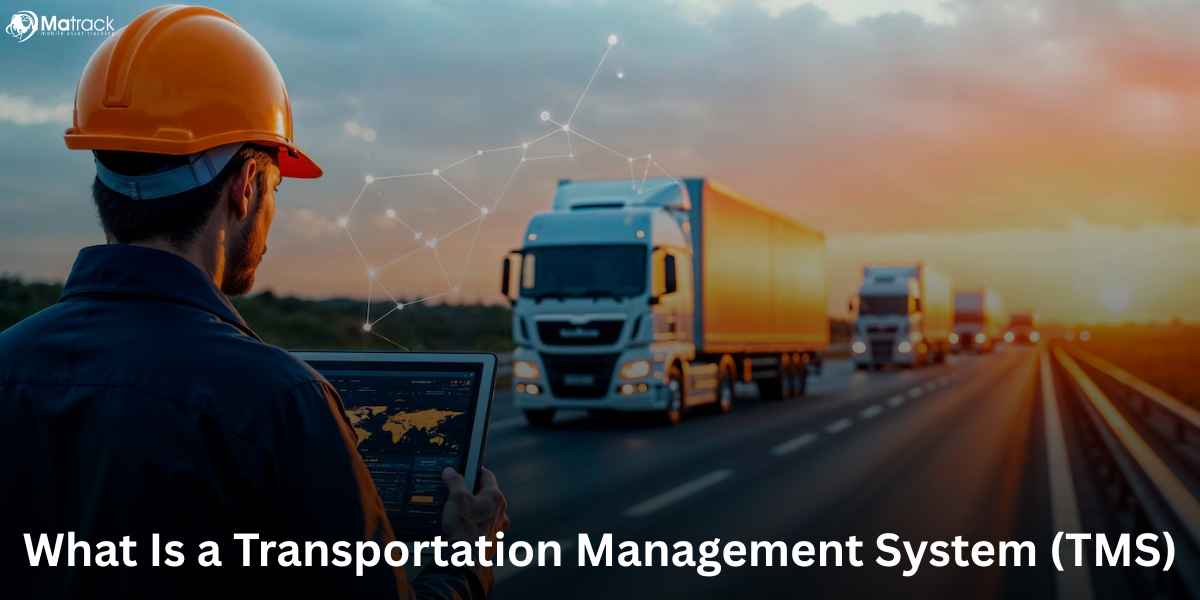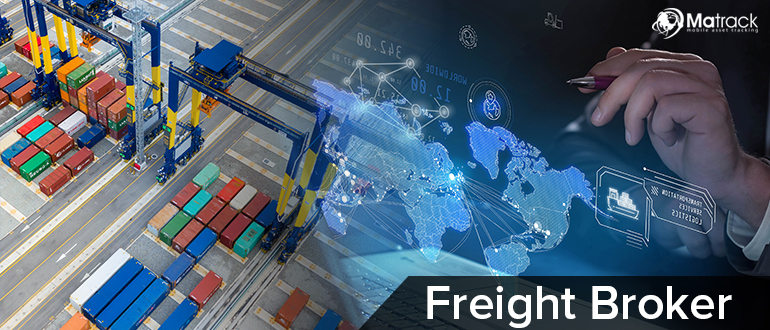Key Takeaways
- A Transportation Management System helps businesses plan, manage, and track shipments efficiently.
- Different TMS types—on-premise, cloud, and hybrid—offer control, flexibility, and scalability options.
- A TMS reduces costs, improves visibility, and supports compliance while facing data and integration challenges.
- Matrack fleet management adds GPS tracking, ELD compliance, and safety tools that strengthen TMS performance.
What Is a TMS System?
A Transportation Management System (TMS) is a software platform that helps businesses plan, execute, and monitor the movement of goods. It gives companies the tools to select the best carriers, create shipping plans, and track deliveries with accuracy.
This system improves logistics by automating manual tasks and reducing costly errors in freight management. Throughout the supply chain, seamless data flow is ensured by integration with other platforms, such as ERP or warehouse management systems.
TMS technology gives complete visibility into shipments and helps control transportation costs at every stage. This level of control explains why a transportation management system is important for companies that depend on reliable logistics.
Why Is a Transportation Management System Important?
A Transportation Management System matters because it makes shipping operations smoother and helps companies keep costs down. It gives businesses the tools to plan shipments smarter, choose the right carriers, and manage freight without unnecessary delays or extra expenses.
Beyond saving money, a TMS gives clear visibility into where shipments are at every step. That means businesses can handle problems faster, keep customers updated, and deliver on time. All of this is possible because of the key functions that a Transportation Management System brings together to manage transportation from start to finish.
What Are Key Functions of a Transportation Management System?
- Shipment Planning: defines routes, modes, and carriers to reduce transit time and cost.
- Carrier Management: handles selection, negotiation, and performance evaluation of transport providers.
- Freight Execution: automates tendering, booking, and documentation with carriers.
- Tracking and Visibility: provide real-time shipment location and status updates.
- Freight Audit and Payment
Freight audit and payment verify charges and automate invoicing. - Analytics and Reporting: generate performance metrics and cost analyses.
How these functions are delivered can vary depending on the kind of system a company uses. That’s why it helps to look at the types of Transportation Management Systems available.
Types of Transportation Management Systems
On-Premise TMS
On-premise TMS installs directly on a company’s own servers, which means the business keeps full control over data, security, and system management. This type works well for companies that need strict data privacy or have complex internal systems that require custom setup.
Cloud-Based TMS
Cloud-based TMS runs on external servers, giving businesses access through the internet without the need for in-house hardware. This option is ideal for companies looking for easier updates, lower upfront costs, and greater scalability as their shipping needs change.
Hybrid TMS
Hybrid TMS blends both on-premise and cloud features to offer a balance between control and flexibility. This type suits businesses that want the security of local systems but also need the accessibility and convenience of cloud tools.
Choosing the right type of TMS depends on how a company wants to manage its shipments, and this choice directly affects the benefits and challenges it can gain from the system.
What Are The Benefits and Challenges of Transportation Management Systems?
| Benefits of a TMS | Common Challenges of a TMS |
| Optimizes routes and transport modes to cut freight costs. | Poor data quality reduces planning and reporting reliability. |
| Automates tasks and removes delays in shipping processes. | Complex system connections create delays and errors. |
| Provides full tracking for managers and customers. | Teams resist shifting from manual to automated systems. |
| Ensures shipments meet regulatory and contractual rules. | Weak carrier alignment limits system performance. |
| Supplies analytics for cost savings and service gains. |
Who Uses a Transportation Management System?
Manufacturers
Manufacturers use TMS platforms to coordinate the movement of raw materials to production sites and finished goods to customers. This level of control keeps production running smoothly and helps meet delivery deadlines.
Distributors and Wholesalers
Distributors and wholesalers depend on a TMS to manage goods as they move through regional or national networks. It helps them plan routes, reduce shipping costs, and ensure that deliveries arrive on time.
Retailers
Retailers rely on TMS solutions to manage shipments between warehouses, stores, and directly to customers. This helps them balance inventory and deliver orders quickly to meet customer expectations.
Third-Party Logistics Providers
Third-party logistics providers use TMS technology to manage shipments for multiple clients. The system allows them to coordinate carrier relationships, optimize routes, and track performance for every load they handle.
E-Commerce Businesses
E-commerce businesses depend on TMS platforms to handle frequent, small shipments efficiently. The system makes it easier to choose the right carrier, track deliveries, and keep customers informed with accurate updates.
When these companies apply a TMS effectively, they gain stronger control over their shipping operations and achieve more consistent results across their supply chains.
How to Implement a Transportation Management System
Define Requirements
Start by analyzing current transportation processes, shipment volumes, carrier networks, and regions served. This helps identify the features and integrations the TMS must support to meet business goals.
Select the Right Vendor
Evaluate TMS providers based on functionality, scalability, ease of integration, and customer support. Comparing vendors ensures the chosen solution aligns with both immediate and long-term operational needs.
Plan System Integration
Develop a plan to connect the TMS with existing systems like ERP, WMS, or order management platforms. A strong integration framework allows data to flow accurately across processes without disruptions.
Configure and Customize
Set up the TMS to match company workflows, business rules, and carrier contracts. Configuration ensures the system reflects real-world shipping operations and helps automate routine tasks.
Test Thoroughly
Run end-to-end tests to validate that planning, booking, tracking, and reporting work as expected. Testing helps identify and correct issues before the system goes live.
Train Teams
Provide hands-on training to staff who will use the TMS. Good training ensures teams understand the system and can use it effectively to manage daily operations.
Launch and Monitor
Once testing and training are complete, roll out the system in stages or all at once depending on business needs. Monitor performance closely after launch to ensure the TMS delivers the expected results.
Future Trends in Transportation Management Systems
IoT Fleet Management
IoT fleet management is giving businesses a clearer view of their vehicles and shipments. With sensors and connected devices, companies can track location, monitor conditions, and spot problems before they cause delays.
Artificial Intelligence and Machine Learning
Artificial intelligence and machine learning are helping TMS platforms make smarter decisions. These tools can find better routes, predict demand, and automate tasks that used to take hours of manual work.
Blockchain for Transparency
Blockchain is adding a new level of security and trust in transportation. It keeps shipping records safe and easy to verify, making it simpler to track goods and meet compliance requirements.
Focus on Sustainability
Sustainability is becoming a bigger part of transportation planning. Many TMS platforms now help businesses choose fuel-efficient routes and track carbon emissions to support greener operations.
Mobile Accessibility
Mobile access is making it easier for teams to stay connected. Whether they’re on the road or in the warehouse, people can update shipment details, check statuses, and keep things moving without delay.
How Matrack Fleet Management Adds Benefits for TMS in Trucking
Matrack fleet management enhances a Transportation Management System by offering precise GPS fleet tracking and real-time telematics data. This helps trucking companies monitor vehicle location, speed, and route progress with greater accuracy.
The use of Matrack’s ELD device ensures that driver hours are recorded automatically and in compliance with regulations. This data integrates with TMS systems to support better scheduling and reduce the risk of violations.
Matrack’s fleet dash cam adds another layer of safety by recording on-road activity and helping resolve disputes quickly. Together, these tools give trucking operations stronger visibility, lower costs, and better control over daily transportation tasks.



